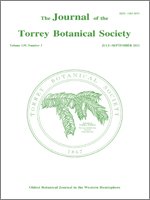Gilland, K. E. (Department of Environmental and Plant Biology, Ohio University, Athens OH 45701), C. H. Keiffer (Department of Botany, Miami University, Oxford OH 45042), and B. C. McCarthy (Department of Environmental and Plant Biology, Ohio University, Athens OH 45701). Seed production of mature forest-grown American chestnut (Castanea dentata (Marsh.) Borkh). J. Torrey Bot. Soc. 139: 283–289. 2012.—Few records concerning pre-blight seed production of forest grown American chestnut (Castanea dentata) exist. As blight resistant American chestnut becomes available to use in restoration efforts, many conservation groups are interested in reintroducing the species as a wildlife food resource. As part of a long-term ecological study involving a disjunct population of American chestnut in Wisconsin, we examined seed production of mature forest grown trees in fall 2005 and 2006. Eleven large diameter (> 23 cm DBH), overstory position, fruiting American chestnuts were selected and measured for height, crown spread, crown volume, and dbh. Because seed predation is intense on this species, we indirectly measured seed production by counting the large opened and spiny cupules (i.e., burs) beneath the tree canopy, along with any cupules remaining on the tree. Castanea dentata typically produces three seeds per cupule, allowing for a reasonably accurate estimate of seed production, and cupules are rarely moved by seed predators. One half of the total projected canopy area was sampled plus an additional meter beyond the canopy edge. This method requires no estimation for losses due to predation or trap damage as found in traditional seed trap experiments. Mean seed production per m2 of basal area was 69,489 in 2005 and 74,825 in 2006. A significant relationship between total number of seeds produced and DBH was found in 2005 but not in 2006. Using basal area measurements from the stand, we would expect 1.04×106 seeds produced per hectare with 2758.5 kg ha−1 of mast production. Based on a sample of seeds we were able to collect from the forest floor, mean seed weight was 2.65 g (± 0.039 SE). Overall, the results indicate that the decline of American chestnut after infection by the chestnut blight likely had a very significant impact on the availability of important wildlife food resources in stands where the species was dominant.
How to translate text using browser tools
1 July 2012
Seed production of mature forest-grown American chestnut (Castanea dentata (Marsh.) Borkh)
Keith E. Gilland,
Carolyn H. Keiffer,
Brian C. McCarthy
ACCESS THE FULL ARTICLE
Castanea dentata
mast
seed production
wildlife
Wisconsin





